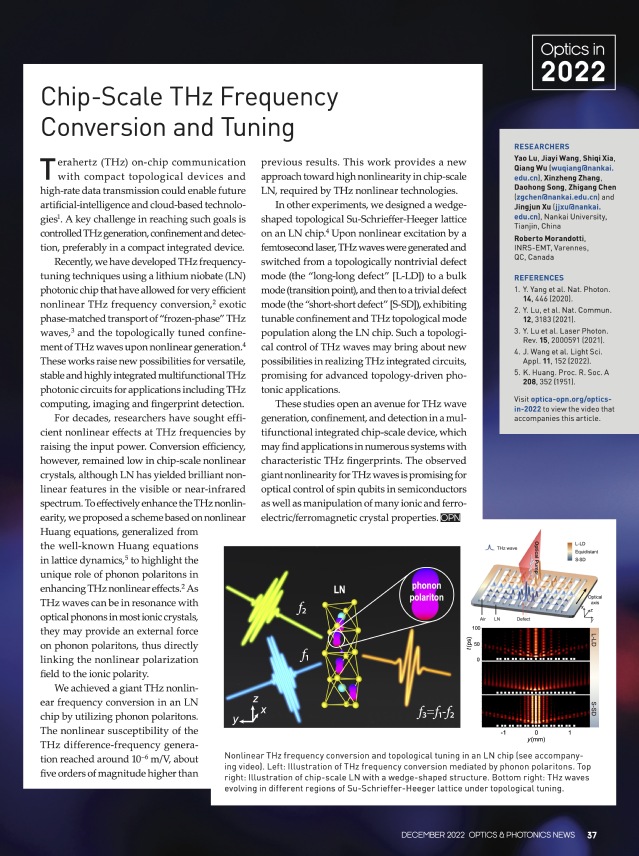In December 2022, Optica (OSA, Optical Society of America) announced the 30 most exciting research in optics and photonics that was published in the special issue of Optics and Photonics News (OPN): Optics in 2022. This is the 40th year of OPN’s annual feature review of 30 stories that they felt communicated breakthroughs of particular interest to the broad optics community. Research “Chip-Scale THz Frequency Conversion and Tuning” from Nankai University, led by Prof. Qiang Wu, Prof. Zhigang Chen, and Prof. Jingjun Xu, was selected as one of them(see paper link 1). The series of research were published in Nature Communications (May 2021), Light: Science & Applications (May 2022), and Laser &Photonics Reviews (May 2021).
Terahertz on-chip communication based on high-rate data transmission can realize future artificial intelligence and cloud-based technologies, where a key challenge to achieve these goals is controlled terahertz generation, confinement, regulation and detection of terahertz waves on a compact integrated platform. In recent years, the research team in Nankai University has developed a terahertz integrated platform based on lithium niobate chips. The report of Optics in 2022 mainly introduces some of the technologies, including on-chip frequency conversion and tuning technology, which can achieve giant nonlinear terahertz frequency conversion (see paper link 2), peculiar frozen-phase terahertz waves transmission (see paper link 3), and topologically tuned terahertz confinement (see paper link 4). These works provide a versatile, stable, and highly integrated multifunctional terahertz integration circuits for applications such as terahertz computing, imaging, and fingerprint detection.
In addition, the latest study of the research team also shows that the employ of stimulated phonon polaritons can also achieve a unique light-matter interaction beyond the traditional Born-Oppenheimer approximation. This result can not only achieve giant nonlinearity and absorption modulation of terahertz waves, but also greatly enhance the nonlinear effect of infrared pulses, which is expected to arise nonlinear tuning mechanisms and approaches that covers very broad wavelengths, from terahertz, infrared, visible, even to ultraviolet band (see paper link 5).
These studies open an avenue for terahertz wave generation, confinement, and detection in a multifunctional integrated chip-scale device, which may find applications in numerous systems with characteristic terahertz fingerprints. The observed giant nonlinearity for both terahertz waves and infrared pulses is promising for optical computing, imaging, and coherent control of spin qubits in semiconductors as well as manipulation of many ionic and ferroelectric/ferromagnetic crystal properties.

Paper links:
1. Y. Lu, et al, OPN: Optics in 2022: 37 (2022).
2. Y. Lu, et al, Nat. Commun. 12: 3183 (2021).
https://www.nature.com/articles/s41467-021-23526-w
3. Y. Lu, et al, Laser Photon. Rev. 15: 2000591 (2021).
https://doi.org/10.1002/lpor.202000591
4. J. Wang, et al, Light Sci. Appl. 11: 152 (2022).
http://dx.doi.org/10.1038/s41377-022-00823-7
5. Y. Lu, et al, Commun. Phys. 5: 299 (2022).
https://doi.org/10.1038/s42005-022-01080-1



